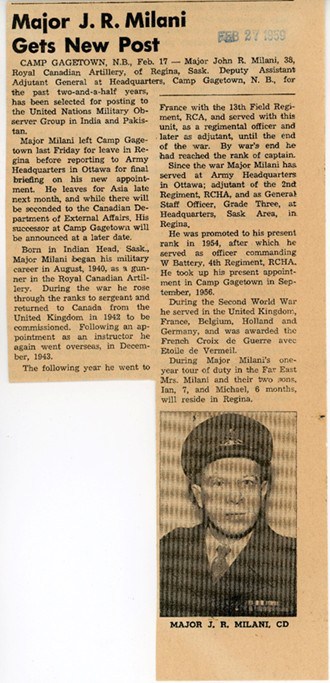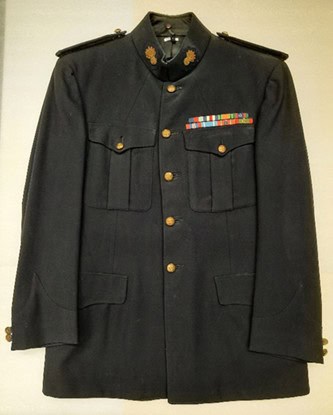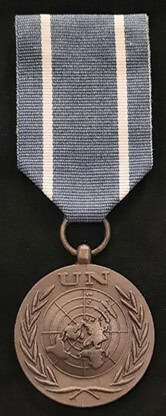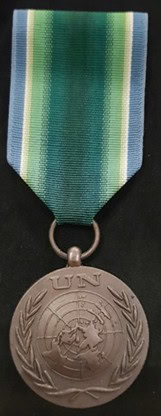The Origins of Canadian Peacekeeping, Part 2: UNMOGIP
The RCA Museum’s temporary exhibit In the Service of Peace: Canada’s Peacekeepers includes artifacts, uniforms, vehicles and media that explain the history of Canadian peacekeeping and peacemaking under UN, NATO and other mandates from the 1950s until today. This year marks the 75th anniversary of the first United Nations peacekeeping operation and the beginnings of the proud tradition of The Royal Regiment of Canadian Artillery in peace operations.
Part 1 of this article series explained the United Nations Truce Supervision Organization (UNTSO) and the role played in it by Maj G.D. Mitchell, RCA. UNTSO was the UN’s first peacekeeping mission and has operated continuously in the Middle East since 29 May 1948.
However, Canada did not send any soldiers on a UN peacekeeping mission until the following year, when the United Nations Military Observer Group in India and Pakistan (UNMOGIP) was established on 24 January 1949 to supervise the truce in the disputed region of Jammu and Kashmir. Leading this first Canadian contingent of eight officers was LCol H.H. “Harry” Angle, a Reservist from Kelowna BC. Promoted to Acting Brigadier in his role as Chief Military Observer of UNMOGIP, Angle sadly died when his aircraft crashed on 17 July 1950 on a flight returning to Jammu and Kashmir from New Delhi. The armoury in Kelowna, where Brigadier Angle had commanded the BC Dragoons, is now named in honour of Canada’s first peacekeeping fatality.

A newspaper clipping from the RCA Museum’s archives dated 27 Feb 1959, announcing of Maj Milani’s posting to UNMOGIP.
The collections and archives of the RCA Museum include artifacts and documents donated by Maj (Ret’d) John Romeo Milani, RCA. When he was asked to summarize his military service on the donation form, he instead sent us his WW2 service record! This invaluable resource tracks his wartime service from 1940 to 1946.
J.R. Milani enlisted as a Gunner on 1 August 1940 at the age of nineteen in his hometown of Indian Head SK in the 60/76th Field Battery. Returning to Canada to commission in 1942, he served in various capacities overseas in the UK and Northwest Europe from 1943 to 1945. Following Victory in Europe, Milani volunteered for the Canadian Army Pacific Force to continue the fight against Imperial Japan.
Milani remained in the Army after the Second World War and held a variety of staff positions, including at NDHQ, at the Royal Canadian Artillery School and with 2 RCHA. After commanding W Battery at 4 RCHA, he was promoted to substantive Major and posted to Camp Gagetown’s HQ in 1956.
It was from this position in Gagetown that Maj Milani was sent to Jammu and Kashmir with the United Nations. The RCA Museum’s archives includes a newspaper clipping dated 27 February 1959 that announces his posting to UNMOGIP and secondment to External Affairs for the mission. Before travelling to Ottawa and then on to South Asia, Milani took leave with his wife and children in Regina, where they would reside during his absence.
Maj Milani served with UNMOGIP from March 1959 to May 1960. The Museum’s archives contain no details on his tour of duty in South Asia, but the mission’s functions were to observe and report any violations of the ceasefire between India and Pakistan, investigating the complaints of either party and reporting their findings to the UN Secretary General.
Upon his return to Canada in 1960, Maj Milani filled staff positions in Ontario and Saskatchewan until his early retirement in December 1967. He worked as Director of Residences and Food Services at the University of Saskatchewan until his second retirement in 1985.
In the late 1980s and early 1990s, Maj Milani donated a number of items to the RCA Museum, including some of his uniforms.


Maj Milani’s partol tunic, with detail of his ribbons (above). The ribbon for his UN service is second from the left in the bottom row.
Maj Milani’s service dress tunic and his patrol dress tunic both retain his ribbons. These ribbons include the 1939-45 Star, the France and Germany Star, the Defence Medal (1939-45), the Canadian Volunteer Service Medal with Overseas Clasp, the 1939-45 War Medal, the UN medal for his service in India and Pakistan, the Canadian Decoration and Clasp, and the Croix de Guerre with Gilt Star. This last honour was bestowed upon Milani by the government of France for his gallant and distinguished action in the Falaise Gap during the Battle of Normandy.


Strangely, the UN ribbons Milani wore on both tunics are not what should be expected. The ribbon for the UNMOGIP medal has a dark green centre fading to light green and then white on either side (representing the Kashmir Valley and the Himalaya Mountains) and edged with UN blue. Instead, Milani’s tunics have the same ribbon awarded for service in UNTSO: a UN blue field with thin white stripes. The UNTSO ribbon was reused for a few other missions, but not for UNMOGIP as far as our research has shown.
Examples of medals from the RCA Museum collection with ribbons for UNTSO (left) and UNMOGIP (right).
Canada participated in UNMOGIP for over four decades, until November 1995. Maj Milani’s time in South Asia is an example of the RCA’s important contributions to peacekeeping around the world. In 2015, the government of France again honoured Milani for his wartime service by appointing him a Knight of the Légion d’honneur. Maj (Ret’d) John Romeo Milani passed away in Regina on 21 May 2016.
The Canadian Peacekeeping Veterans Association is compiling personal reflections to mark the 75th anniversary of UN peacekeeping. Visit https://www.cpva.ca/ to read the contributions or contribute your own story.
By Jonathan Ferguson
